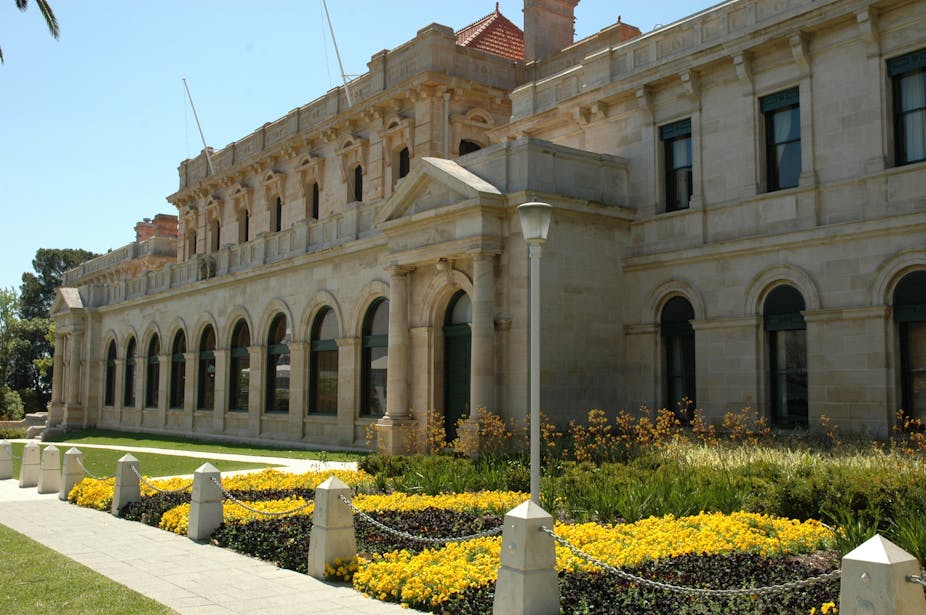Gina Rinehart’s father Lang Hancock was a big proponent of Western Australia seceding from the Australian federation, and every time the latest figures on GST distributions are released, sympathetic sentiments come blowing east across the Nullabor.
But could Western Australia, or any state for that matter, actually declare independence and leave?
While the Australian Constitution allows for an increase in the number of member states of the federation, it makes no provision for existing states to secede from the union.
Secession refers to an act by a political community to withdraw from the jurisdiction of a larger entity of which it is a constituent member. It is, in essence, an action intended to result in full self-government.
The demand to secede generally has one of two objectives at its core. Secession may be an end in itself in which case the protagonists are desirous to dissolve the union, or some aspect of it, in its present form. In other cases, secessionist claims constitute part of a strategic bargaining process to force the central government (or their counterparts) to take their concerns seriously.
The preamble of the Commonwealth of Australia Constitution Act makes clear that the original states are united in an indissoluble union.
John Quick and Robert Garran, who wrote the annotated Constitution, argued that the framers inserted a reference to the indissolubility of the federation as a reminder that the union established under the new Act should not be undone by the people.
In spite of the political jostling that takes place between state premiers and the Commonwealth, the Australian federation has been a stable institution. Only Western Australia has seriously pursued the secession option. Its most famous attempt to exit the federation occurred in 1933 when, following a successful referendum of its people, the WA government presented a petition to secede to the Imperial parliament.
The British rejected the application on the grounds that it would only entertain a request to alter the Constitution on instruction of the Commonwealth parliament.
But is the federation a perpetual union from which no state could conceivably secede?
There are two potential avenues available to an Australian state intent on such a course of action, although both options are contested by legal scholars to a greater or lesser extent.
The first of these is that a state could petition the Commonwealth parliament to hold a referendum pursuant to section 128 of the Constitution. Assuming federal parliament was willing to oblige such a request, the proposal would then have to be assented to by a majority of the Australian population along with the majority of the states.

The second option would be for a state to secede unilaterally. This would entail an Australian state passing an Act of its own parliament declaring its withdrawal from the federation and asserting its status as a fully sovereign nation. Such an action is regarded by many legal scholars as unlawful.
Notwithstanding the constitutionality or otherwise of unilateral secession, such a course of action is possible in practice. A state could only be prevented from pursuing this option if the Commonwealth was prepared to use the military to force the seceding state to remain in the federation against its will. The scenario of the Commonwealth invading a state seems preposterous, although cannot be entirely dismissed.
In the end, the legalities of dissolving the federation are nothing compared to the logistics of an Australian state opting for full independence.
Federations allow smaller sovereign units to share the burden of some of the more onerous costs associated with running and maintaining the territory under its control. For any of the states to become fully self-supporting on terms that local populations are presently accustomed would be difficult, given the size of the territories that states’ administer and their diminutive local populations.
It would be a challenge for any existing state to acquire all of the trappings associated with nationhood. The new nation would have to establish its own military, police its own borders, print its own currency and issue its own passports. It would be required to radically extend its bureaucratic apparatus, particularly in respect to revenue and taxation collection. It would also have to forge its own diplomatic ties and treaties with other sovereign nations, including with the federation from which it had withdrawn.
Even the serial secessionist of the federation, Western Australia, does not have the stomach to pursue full self determination. Even at the height of WA’s recent discontent over the mining tax, the state’s premier Colin Barnett positively rejected any suggestion that WA had any intention of seceding from the federation.
But does this mean necessarily that it is futile for a state to talk of secession?
Campbell Sharman, a political scientist formerly based at the University of Western Australia, has argued that:
…thinking about the justifications for secession forces us to realise where our system of government is defective and needs repairing.
As the federation continues to be eroded in ways that further undermine the autonomy of the states, the threat of secession serves as a reminder to central government that the states harbour genuine grievances that need urgent and serious attention.

